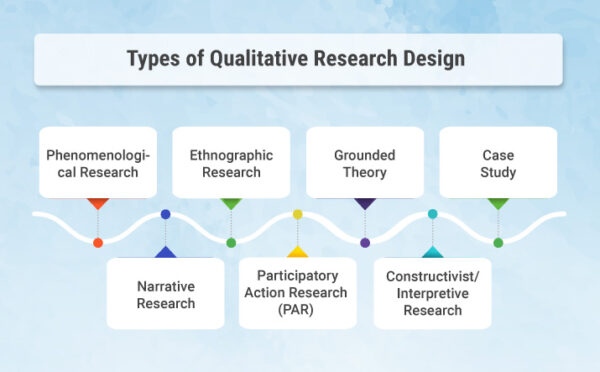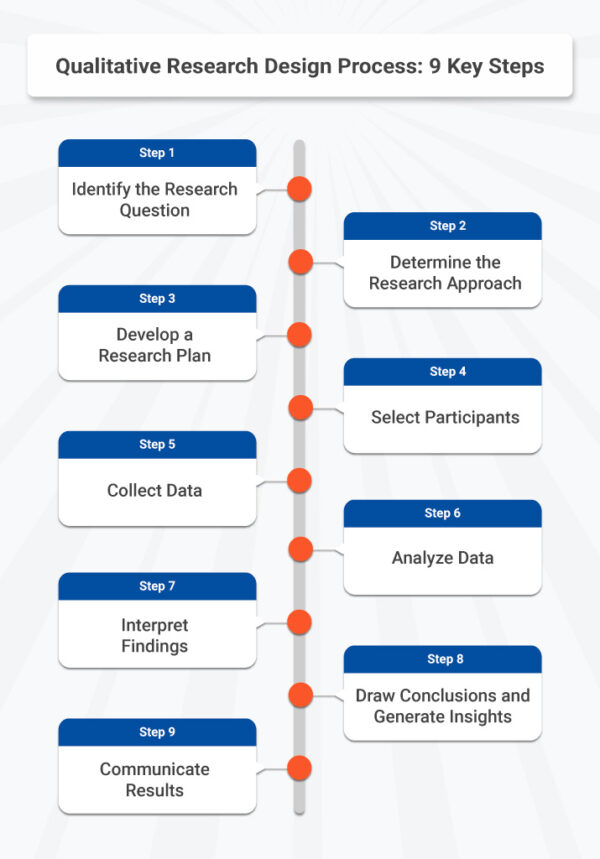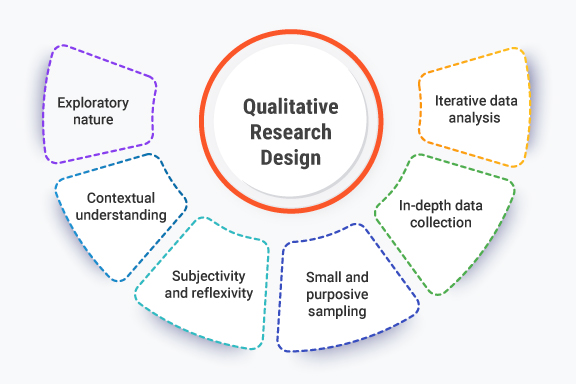What is Qualitative Research Design?
Qualitative research design is defined as a type of research methodology that focuses on exploring and understanding complex phenomena and the meanings attributed to them by individuals or groups. It is commonly used in social sciences, psychology, anthropology, and other fields where subjective experiences and interpretations are of interest.
Qualitative research is concerned with capturing the richness and depth of human experiences, beliefs, attitudes, and behaviors. It aims to go beyond simple statistical analysis and uncover insights that quantitative research may not be able to capture.
Qualitative research design typically involves gathering data through methods such as interviews, observations, focus groups, and analysis of documents or artifacts. These methods allow researchers to collect detailed, descriptive information about participants’ perspectives, experiences, and contexts.
Key characteristics of qualitative research design include:
- Exploratory nature: Qualitative research often begins with an open-ended approach to allow for the discovery of new insights and patterns.
- Contextual understanding: It emphasizes understanding phenomena within their social, cultural, and historical contexts, as these factors shape individuals’ experiences.
- Subjectivity and reflexivity: Qualitative researchers acknowledge the influence of their own perspectives and biases and often engage in reflexivity to critically examine their role in shaping the research process and outcomes.
- Small and purposive sampling: Rather than aiming for large representative samples, qualitative research often involves selecting participants who can provide rich and diverse information relevant to the research question.
- In-depth data collection: Researchers spend considerable time with participants, collecting detailed and nuanced data, often through open-ended interviews, observations, or analysis of texts.
- Iterative data analysis: Qualitative analysis involves coding, categorizing, and interpreting data to identify patterns, themes, and relationships. This process is often iterative, with researchers revisiting and refining their analysis as new insights emerge.
Types of Qualitative Research Design

There are several types of qualitative research designs, each with its own specific characteristics and purposes. Here are some common types:
- Phenomenological Research
This design aims to understand the essence and meaning of human experiences related to a particular phenomenon. Researchers explore participants’ subjective experiences through in-depth interviews or observations to uncover the underlying structures and patterns of their lived experiences.
- Ethnographic Research
Ethnography involves studying and understanding the culture, beliefs, practices, and social interactions of a specific group or community. Researchers immerse themselves in the participants’ natural environment for an extended period, often conducting participant observation, interviews, and document analysis to gain an in-depth understanding of the culture.
- Grounded Theory
Grounded theory is an approach where researchers aim to develop theories or conceptual frameworks grounded in the data. Through constant comparison and analysis of collected data, researchers identify categories, concepts, and relationships to generate a theory that explains the phenomenon under investigation.
- Case Study
Case study research involves an in-depth examination of a single individual, group, organization, or specific context. Researchers collect multiple sources of data such as interviews, observations, and documents to provide a comprehensive understanding of the case and to draw insights that may have broader implications.
- Narrative Research
Narrative research focuses on understanding and analyzing the stories and personal narratives shared by individuals. Researchers examine the structure, content, and context of these narratives to gain insights into how individuals construct meaning and make sense of their experiences.
- Participatory Action Research (PAR)
PAR is a collaborative approach that involves researchers working closely with participants or communities to identify and address social issues or problems. The aim is to empower participants and generate actionable knowledge through a cyclical process of reflection, action, and change.
- Constructivist/Interpretive Research
This design emphasizes the importance of understanding multiple subjective realities and interpretations of social phenomena. Researchers explore the different meanings and perspectives attributed to a phenomenon, often using interviews, focus groups, or textual analysis to uncover the complexities of individuals’ interpretations.
Learn more: What is Qualitative Market Research?
Qualitative Research Design Methods
Whether you’re a seasoned researcher or new to the field, this comprehensive resource will equip you with the tools and techniques needed to conduct impactful qualitative research.
- Interviews: Gain In-Depth Insights Discover the nuances of conducting interviews, from structured to unstructured approaches. Learn how to ask the right questions, build rapport with participants, and extract valuable insights into their experiences, beliefs, and attitudes.
- Observations: Decode Human Behavior Explore the world of observational research and learn how to systematically observe and record human behavior in natural or controlled settings. From participant to non-participant observation, uncover the secrets to decoding social interactions and contextual factors.
- Focus Groups: Harness Collective Wisdom Harness the power of group dynamics with focus groups. Delve into the process of facilitating discussions, eliciting diverse perspectives, and uncovering shared insights that drive actionable outcomes.
- Case Studies: Unravel Complex Phenomena Embark on an in-depth exploration of single cases to unravel complex phenomena. Dive deep into the world of case studies, gathering multiple data sources to provide a comprehensive understanding within real-world contexts.
- Ethnography: Immerse Yourself in Culture Immerse yourself in the cultural context of your research subjects with ethnographic methods. From participant observation to in-depth interviews, learn how to capture the essence of cultural practices and social interactions.
- Visual Methods: Enhance Understanding Elevate your research with visual methods, from photography to video recordings. Explore how visual data can complement traditional methods, providing additional insights and documentation of participants’ experiences.
- Textual Analysis: Uncover Hidden Patterns Master the art of textual analysis and uncover hidden patterns and meanings within written or verbal data. From coding techniques to thematic analysis, unlock the secrets buried within the text.
Armed with a newfound understanding of qualitative research methods, you’re ready to embark on a journey of discovery. Whether you’re exploring new territories or refining existing practices, our guide will empower you to navigate the complexities of human behavior and unlock insights that drive meaningful change.
Qualitative Research Design Process: 9 Key Steps

The qualitative research design process typically involves several key steps. While the specific details may vary depending on the research context and methodology, here is a general overview of the steps involved:
1. Identify the Research Question
Start by providing a concise and unambiguous statement that outlines your research question or objective. What do you want to explore or understand through your qualitative research? Ensure that the question is specific, focused, and relevant to your field of study.
2. Determine the Research Approach
Select the most appropriate qualitative research approach or design based on your research question and objectives. Consider the different types of qualitative research designs (such as phenomenology, ethnography, and grounded theory) and choose one that aligns with your research goals.
3. Develop a Research Plan
Create a research plan that outlines the steps, procedures, and timeline for your study. Identify the target population or participants, data collection methods, and data analysis techniques you intend to use.
4. Select Participants
Determine the criteria for selecting participants who can provide valuable insights related to your research question. Consider factors such as demographics, expertise, experiences, or specific characteristics relevant to your study. Choose a sampling method (e.g., purposive sampling, snowball sampling) to recruit participants.
5. Collect Data
Conduct data collection using the chosen qualitative methods. This may involve conducting interviews, observations, focus groups, or document analysis. To maintain ethical standards, it is crucial to adhere to ethical guidelines and ensure that participants provide informed consent. Consider audio or video recording to ensure accurate data capture.
6. Analyze Data
Engage in data analysis to identify patterns, themes, and insights from the collected data. This may involve coding, categorizing, and organizing the data using qualitative analysis software or manual techniques. Use iterative and reflexive processes to refine and deepen your analysis.
7. Interpret Findings
Interpret the findings based on the analysis of your data. Explore the emerging themes, relationships, and meanings that have emerged from the data. Consider how the findings relate to your research question and existing literature in your field.
8. Draw Conclusions and Generate Insights
Summarize the key findings of your study and draw conclusions based on your interpretation of the data. Reflect on the implications and significance of your findings for theory, practice, or future research. Identify any limitations or potential biases in your study.
9. Communicate Results
Prepare a report or manuscript to communicate your research findings. Present your qualitative data, analysis, interpretations, and conclusions in a clear and organized manner. Consider sharing your findings through presentations, publications, or other appropriate dissemination channels.
Learn more: What is Quantitative Market Research?
Top 12 best practices for qualitative research design
When conducting qualitative research, it is important to follow best practices to ensure the rigor, validity, and trustworthiness of your study. Here are some top best practices for qualitative research design:
1. Clearly Define Research Questions: Begin by clearly defining your research questions or objectives. Make sure they are specific, focused, and aligned with the purpose of your study. Clearly articulating your research questions will guide your entire research design.
2. Use a Theoretical Framework: Situate your research within a relevant theoretical framework or existing body of literature. This provides a foundation for understanding the context and helps you generate insights that contribute to theory development or refinement.
3. Select an Appropriate Research Design: Choose a qualitative research design that best suits your research questions and objectives. Consider the different approaches available, such as phenomenology, ethnography, or grounded theory, and select the one that aligns with your research goals.
4. Use Rigorous Sampling Techniques: Select participants or cases using rigorous sampling techniques. Consider purposeful sampling, where participants are chosen based on specific criteria relevant to your research question. Aim for diversity and seek saturation, where data collection reaches a point of redundancy and further data collection does not yield significant new insights.
5. Establish Trustworthiness and Credibility: Enhance the trustworthiness of your research findings by employing strategies such as member checking, where participants review and validate your interpretations, or peer debriefing, where colleagues provide feedback on your analysis and interpretations. Triangulation, or the use of multiple data sources or methods, can also strengthen the credibility of your findings.
6. Maintain Reflexivity: Be aware of your own biases, assumptions, and preconceptions throughout the research process. Engage in reflexivity by regularly reflecting on how your own perspectives may influence data collection, analysis, and interpretation. Documenting and acknowledging your own role and potential impact on the research process is essential.
7. Plan and Conduct Ethical Research: Adhere to ethical guidelines and obtain informed consent from participants. Ensure participant confidentiality, anonymity, and privacy. Seek ethics approval from relevant institutional review boards or ethics committees.
8. Use Clear and Consistent Data Collection Methods: Follow established protocols and guidelines for data collection methods such as interviews, observations, or document analysis. Develop interview guides or observation protocols to ensure consistency and standardization across participants or cases.
9. Maintain Detailed Documentation: Keep comprehensive records of your research process, including field notes, transcripts, or analysis memos. Thorough documentation allows for transparency, traceability, and the potential for independent audit or replication of your study.
10. Engage in Iterative Data Analysis: Conduct data analysis iteratively throughout the research process. Use coding techniques, thematic analysis, or other appropriate qualitative research methods to identify patterns, themes, and relationships in the data. Allow for revisions, refinements, and further exploration of emerging insights.
11. Ensure Researcher Independence and Objectivity: Be mindful of your own biases and maintain researcher independence throughout the research process. Strive for objectivity by critically examining your interpretations, seeking alternative explanations, and engaging in peer debriefing or external review.
12. Communicate Findings Effectively: Clearly communicate your research findings, including the methodology, data analysis, interpretations, and limitations. Provide rich and detailed descriptions to support your arguments and conclusions. Consider presenting findings in a way that resonates with your intended audience, whether it be academic researchers, practitioners, or policymakers.
Learn more: What is Qualitative Observation?

